Spatiotemporal Pattern and Spatial Convergence of Land Use Carbon Emission Efficiency in the Pan-Pearl River Delta: Based on the Difference in Land Use Carbon Budget
Abstract
:1. Introduction
2. Materials and Methods
2.1. Research Framework
2.2. Study Area Overview
2.3. Research Methods
2.3.1. Estimation Methods for LUCB
- Estimation Methods for Land Use Carbon Emissions
- 2.
- Estimation Method for Land Use Carbon Absorption.
- 3.
- Estimation Method for NCELU.
2.3.2. SBM-Undesirable Model
2.3.3. Exploratory Spatial Data Analysis (ESDA)
2.3.4. Dagum Gini Coefficient Decomposition Method
2.3.5. Spatial Convergence Model
2.4. Indicator System Construction and Data Sources
2.4.1. Indicator System Construction
2.4.2. Data Sources and Data Processing
3. Results
3.1. Analysis of LUCC and the Difference in LUCB
3.1.1. Analysis of LUCC
3.1.2. Analysis of the Spatial and Temporal Variations in LUCB
3.2. Spatiotemporal Pattern Analysis of LUCEE
3.3. Spatial Correlation Analysis of LUCEE
3.3.1. Global Spatial Autocorrelation Analysis of LUCEE
3.3.2. Local Spatial Autocorrelation Analysis of the LUCEE
3.4. Regional Difference Analysis of LUCEE
3.5. Convergence Analysis of LUCEE
3.5.1. Convergence Model Selection
3.5.2. Absolute Convergence Analysis of LUCEE
3.5.3. Conditional Convergence Analysis of LUCEE
4. Discussion
4.1. Result Analysis
4.2. Policy Recommendations
5. Conclusions
Author Contributions
Funding
Data Availability Statement
Conflicts of Interest
References
- Gui, D.; He, H.; Liu, C.; Han, S. Spatio-temporal dynamic evolution of carbon emissions from land use change in Guangdong Province, China, 2000–2020. Ecol. Indic. 2023, 156, 111131. [Google Scholar] [CrossRef]
- Friedlingstein, P.; O’Sullivan, M.; Jones, M.W.; Andrew, R.M.; Bakker, D.C.E.; Hauck, J.; Landschützer, P.; Le Quéré, C.; Luijkx, I.T.; Peters, G.P.; et al. Global Carbon Budget 2023. Earth Syst. Sci. Data 2023, 15, 5301–5369. [Google Scholar] [CrossRef]
- Pan, X.; Guo, S.; Xu, H.; Tian, M.; Pan, X.; Chu, J. China’s carbon intensity factor decomposition and carbon emission decoupling analysis. Energy 2022, 239, 122175. [Google Scholar] [CrossRef]
- Hong, Y.; Yu, H.; Lu, Y.; Peng, L. Balancing low-carbon and eco-friendly development: Coordinated development strategy for land use carbon emission efficiency and land ecological security. Environ. Sci. Pollut. Res. 2024, 31, 9495–9511. [Google Scholar] [CrossRef] [PubMed]
- Feng, W.; Zhao, R.; Xie, Z.; Ding, M.; Xiao, L.; Sun, J.; Yang, Q.; Liu, T.; You, Z. Land Use Carbon Emission Efficiency and Its Spatial-temporal Pattern under Carbon Neutral Target: A Case Study of 72 Cities in the Yellow River Basin. China Land Sci. 2023, 37, 102–113. [Google Scholar]
- Wang, Y.; Chai, J.; Zhang, H.; Yang, B. Evaluating construction land use efficiency under carbon emission constraints: A comparative study of China and the USA. Environ. Sci. Pollut. Res. 2022, 29, 49998–50009. [Google Scholar] [CrossRef] [PubMed]
- Dong, F.; Zhu, J.; Li, Y.; Chen, Y.; Gao, Y.; Hu, M.; Qin, C.; Sun, J. How green technology innovation affects carbon emission efficiency: Evidence from developed countries proposing carbon neutrality targets. Environ. Sci. Pollut. Res. 2022, 29, 35780–35799. [Google Scholar] [CrossRef]
- Wang, T.; Li, H. Assessing the spatial spillover effects and influencing factors of carbon emission efficiency: A case of three provinces in the middle reaches of the Yangtze River, China. Environ. Sci. Pollut. Res. 2023, 30, 119050–119068. [Google Scholar] [CrossRef] [PubMed]
- Meng, Q.; Zheng, Y.; Liu, Q.; Li, B.; Wei, H. Analysis of Spatiotemporal Variation and Influencing Factors of Land-Use Carbon Emissions in Nine Provinces of the Yellow River Basin Based on the LMDI Model. Land 2023, 12, 437. [Google Scholar] [CrossRef]
- Lu, X.; Zhang, Y.; Li, J.; Duan, K. Measuring the urban land use efficiency of three urban agglomerations in China under carbon emissions. Environ. Sci. Pollut. Res. 2022, 29, 36443–36474. [Google Scholar] [CrossRef]
- Tone, K. A slacks-based measure of efficiency in data envelopment analysis. Eur. J. Oper. Res. 2001, 130, 498–509. [Google Scholar] [CrossRef]
- Yang, B.; Chen, X.; Wang, Z.; Li, W.; Zhang, C.; Yao, X. Analyzing land use structure efficiency with carbon emissions: A case study in the Middle Reaches of the Yangtze River, China. J. Clean. Prod. 2020, 274, 123076. [Google Scholar] [CrossRef]
- Meng, F.; Su, B.; Thomson, E.; Zhou, D.; Zhou, P. Measuring China’s regional energy and carbon emission efficiency with DEA models: A survey. Appl. Energy 2016, 183, 1–21. [Google Scholar] [CrossRef]
- Kuang, B.; Lu, X.; Zhou, M.; Chen, D. Provincial cultivated land use efficiency in China: Empirical analysis based on the SBM-DEA model with carbon emissions considered. Technol. Forecast. Soc. Change 2020, 151, 119874. [Google Scholar] [CrossRef]
- Lv, T.; Geng, C.; Zhang, X.; Li, Z.; Hu, H.; Fu, S. Impact of the intensive use of urban construction land on carbon emission efficiency: Evidence from the urban agglomeration in the middle reaches of the Yangtze River. Environ. Sci. Pollut. Res. 2023, 30, 113729–113746. [Google Scholar] [CrossRef]
- Liu, X.; Wang, P.; Song, H.; Zeng, X. Determinants of net primary productivity: Low-carbon development from the perspective of carbon sequestration. Technol. Forecast. Soc. Change 2021, 172, 121006. [Google Scholar] [CrossRef]
- Guan, X.; Shen, H.; Li, X.; Gan, W.; Zhang, L. A long-term and comprehensive assessment of the urbanization-induced impacts on vegetation net primary productivity. Sci. Total Environ. 2019, 669, 342–352. [Google Scholar] [CrossRef]
- Potter, C.S.; Randerson, J.T.; Field, C.B.; Matson, P.A.; Vitousek, P.M.; Mooney, H.A.; Klooster, S.A. Terrestrial ecosystem production: A process model based on global satellite and surface data. Glob. Biogeochem. Cycles 1993, 7, 811–841. [Google Scholar] [CrossRef]
- Ichii, K.; Matsui, Y.; Yamaguchi, Y.; Ogawa, K. Comparison of global net primary production trends obtained from satellite-based normalized difference vegetation index and carbon cycle model. Glob. Biogeochem. Cycles 2001, 15, 351–363. [Google Scholar] [CrossRef]
- Wu, Y.; Wang, P.; Liu, X.; Chen, J.; Song, M. Analysis of regional carbon allocation and carbon trading based on net primary productivity in China. China Econ. Rev. 2020, 60, 101401. [Google Scholar] [CrossRef]
- Zhu, W.; Pan, Y.; Zhang, J. Estimation of net primary productivity of Chinese terrestrial vegetation based on remote sensing. Chin. J. Plant Ecol. 2007, 31, 413. [Google Scholar]
- Zhang, C.-Y.; Zhao, L.; Zhang, H.; Chen, M.-N.; Fang, R.-Y.; Yao, Y.; Zhang, Q.-P.; Wang, Q. Spatial-temporal characteristics of carbon emissions from land use change in Yellow River Delta region, China. Ecol. Indic. 2022, 136, 108623. [Google Scholar] [CrossRef]
- Zhang, B.; Yin, J.; Jiang, H.; Chen, S.; Ding, Y.; Xia, R.; Wei, D.; Luo, X. Multi-source data assessment and multi-factor analysis of urban carbon emissions: A case study of the Pearl River Basin, China. Urban Clim. 2023, 51, 101653. [Google Scholar] [CrossRef]
- Cui, X.; Lei, Y.; Zhang, F.; Zhang, X.; Wu, F. Mapping spatiotemporal variations of CO2 (carbon dioxide) emissions using nighttime light data in Guangdong Province. Phys. Chem. Earth Parts A/B/C 2019, 110, 89–98. [Google Scholar] [CrossRef]
- Sun, Y.; Zheng, S.; Wu, Y.; Schlink, U.; Singh, R.P. Spatiotemporal Variations of City-Level Carbon Emissions in China during 2000–2017 Using Nighttime Light Data. Remote Sens. 2020, 12, 2916. [Google Scholar] [CrossRef]
- Yang, Q.; Pu, L.; Jiang, C.; Gong, G.; Tan, H.; Wang, X.; He, G. Unveiling the spatial-temporal variation of urban land use efficiency of Yangtze River Economic Belt in China under carbon emission constraints. Front. Environ. Sci. 2023, 10, 1096087. [Google Scholar] [CrossRef]
- Zhang, A.; Deng, R. Spatial-temporal evolution and influencing factors of net carbon sink efficiency in Chinese cities under the background of carbon neutrality. J. Clean. Prod. 2022, 365, 132547. [Google Scholar] [CrossRef]
- Lu, X.; Kuang, B.; Li, J. Regional difference decomposition and policy implications of China’s urban land use efficiency under the environmental restriction. Habitat Int. 2018, 77, 32–39. [Google Scholar] [CrossRef]
- Wang, Z.; Shao, H. Spatiotemporal differences in and influencing factors of urban carbon emission efficiency in China’s Yangtze River Economic Belt. Environ. Sci. Pollut. Res. 2023, 30, 121713–121733. [Google Scholar] [CrossRef]
- Yang, H.; Wu, Q. Land use eco-efficiency and its convergence characteristics under the constraint of carbon emissions in China. Int. J. Environ. Res. Public Health 2019, 16, 3172. [Google Scholar] [CrossRef]
- Fan, X.; Jiang, X. Regional differences and convergence of urban land green use efficiency in China under the constraints of carbon neutrality. Environ. Dev. Sustain. 2023, 1–27. [Google Scholar] [CrossRef]
- Li, G.; Kuang, Y.; Huang, N.; Chang, X. Emergy synthesis and regional sustainability assessment: Case study of pan-pearl river delta in China. Sustainability 2014, 6, 5203–5230. [Google Scholar] [CrossRef]
- Ye, Y.; Yan, S.; Zhu, S. Growth Trends and Heterogeneity of Total Factor Productivity in Nine Pan-PRD Provinces in China. Sustainability 2022, 14, 14154. [Google Scholar] [CrossRef]
- Liu, T.; Li, Y. Green development of China’s Pan-Pearl River Delta mega-urban agglomeration. Sci. Rep. 2021, 11, 15717. [Google Scholar] [CrossRef] [PubMed]
- Xi, X.; Wang, L. Factor Decomposition of Regional Economic Difference in Pan-Pearl River Delta. Geogr. Geo-Inf. Sci. 2008, 24, 51–56+65. [Google Scholar]
- Yang, S.F.; Fu, W.J.; Hu, S.G.; Ran, P.L. Watershed carbon compensation based on land use change: Evidence from the Yangtze River Economic Belt. Habitat Int. 2022, 126, 102613. [Google Scholar] [CrossRef]
- Lin, Q.; Zhang, L.; Qiu, B.; Zhao, Y.; Wei, C. Spatiotemporal Analysis of Land Use Patterns on Carbon Emissions in China. Land 2021, 10, 141. [Google Scholar] [CrossRef]
- Qin, J.; Gong, N. The estimation of the carbon dioxide emission and driving factors in China based on machine learning methods. Sustain. Prod. Consum. 2022, 33, 218–229. [Google Scholar] [CrossRef]
- 2006 IPCC Guidelines for National Greenhouse Gas Inventories. Available online: https://www.ipcc-nggip.iges.or.jp/public/2006gl/index.html (accessed on 25 September 2023).
- Zhang, L.; Lei, J.; Wang, C.; Wang, F.; Geng, Z.; Zhou, X. Spatio-temporal variations and influencing factors of energy-related carbon emissions for Xinjiang cities in China based on time-series nighttime light data. J. Geogr. Sci. 2022, 32, 1886–1910. [Google Scholar] [CrossRef]
- Wei, W.; Du, H.; Ma, L.; Liu, C.; Zhou, J. Spatiotemporal dynamics of CO2 emissions using nighttime light data: A comparative analysis between the Yellow and Yangtze River Basins in China. Environ. Dev. Sustain. 2022, 26, 1081–1102. [Google Scholar] [CrossRef]
- Yang, Z.; Chen, Y.; Guo, G.; Zheng, Z.; Wu, Z. Using nighttime light data to identify the structure of polycentric cities and evaluate urban centers. Sci. Total Environ. 2021, 780, 146586. [Google Scholar] [CrossRef]
- Chen, S.; Tan, Z.; Mu, S.; Wang, J.; Chen, Y.; He, X. Synergy level of pollution and carbon reduction in the Yangtze River Economic Belt: Spatial-temporal evolution characteristics and driving factors. Sustain. Cities Soc. 2023, 98, 104859. [Google Scholar] [CrossRef]
- Chen, Z.; Liu, Y.; Lin, H. Decoupling Analysis of Land-Use Carbon Emissions and Economic Development in Guangdong Province. Ecol. Econ. 2018, 34, 26–32. [Google Scholar]
- West, T.O.; Marland, G. A synthesis of carbon sequestration, carbon emissions, and net carbon flux in agriculture: Comparing tillage practices in the United States. Agric. Ecosyst. Environ. 2002, 91, 217–232. [Google Scholar] [CrossRef]
- Li, X.; Xiong, S.; Li, Z.; Zhou, M.; Li, H. Variation of global fossil-energy carbon footprints based on regional net primary productivity and the gravity model. J. Clean. Prod. 2019, 213, 225–241. [Google Scholar] [CrossRef]
- Anselin, L.; Sridharan, S.; Gholston, S. Using Exploratory Spatial Data Analysis to Leverage Social Indicator Databases: The Discovery of Interesting Patterns. Soc. Indic. Res. 2007, 82, 287–309. [Google Scholar] [CrossRef]
- Dagum, C. A new approach to the decomposition of the Gini income inequality ratio. Empir. Econ. 1997, 4, 515–531. [Google Scholar] [CrossRef]
- Zhang, L.; Ma, X.; Ock, Y.-S.; Qing, L. Research on Regional Differences and Influencing Factors of Chinese Industrial Green Technology Innovation Efficiency Based on Dagum Gini Coefficient Decomposition. Land 2022, 11, 122. [Google Scholar] [CrossRef]
- Han, H.; Ding, T.; Nie, L.; Hao, Z. Agricultural eco-efficiency loss under technology heterogeneity given regional differences in China. J. Clean. Prod. 2020, 250, 119511. [Google Scholar] [CrossRef]
- Liu, N.; Wang, Y. Urban Agglomeration Ecological Welfare Performance and Spatial Convergence Research in the Yellow River Basin. Land 2022, 11, 2073. [Google Scholar] [CrossRef]
- Yu, Q.; Li, Y.; Zhu, Y.; Chen, B.; Wang, Q.; Huang, D.; Wen, C. Spatiotemporal divergence and convergence test of green total factor productivity of grain in China: Based on the dual perspective of carbon emissions and surface source pollution. Environ. Sci. Pollut. Res. 2023, 30, 80478–80495. [Google Scholar] [CrossRef] [PubMed]
- Ge, K.; Zou, S.; Chen, D.; Lu, X.; Ke, S. Research on the Spatial Differences and Convergence Mechanism of Urban Land Use Efficiency under the Background of Regional Integration: A Case Study of the Yangtze River Economic Zone, China. Land 2021, 10, 1100. [Google Scholar] [CrossRef]
- Liu, M.; Zhang, A.; Wen, G. Regional differences and spatial convergence in the ecological efficiency of cultivated land use in the main grain producing areas in the Yangtze Region. J. Nat. Resour. 2022, 37, 477–493. [Google Scholar] [CrossRef]
- Meng, Q.; Liu, Q.; Li, B.; Zheng, Y.; Cai, E. Decoupling Relationship Between Land Use Intensity and Carbon Emissions in Henan Province During 2000—2020. Bull. Soil Water Conserv. 2023, 43, 421–429. [Google Scholar]
- Ali, G.; Nitivattananon, V. Exercising multidisciplinary approach to assess interrelationship between energy use, carbon emission and land use change in a metropolitan city of Pakistan. Renew. Sustain. Energy Rev. 2012, 16, 775–786. [Google Scholar] [CrossRef]
- Wu, Y.; Shi, K.; Chen, Z.; Liu, S.; Chang, Z. Developing Improved Time-Series DMSP-OLS-Like Data (1992–2019) in China by Integrating DMSP-OLS and SNPP-VIIRS. IEEE Trans. Geosci. Remote Sens. 2022, 60, 4407714. [Google Scholar] [CrossRef]
- Gao, J.; Shi, Y.; Zhang, H.; Chen, X.; Zhang, W.; Shen, W.; Xiao, T.; Zhang, Y. China Regional 250 m Normalized Difference Vegetation Index Data Set (2000–2022); National Tibetan Plateau/Third Pole Environment Data Center: Tibet, China, 2023. [Google Scholar]
- Yang, J.; Huang, X. The 30 m annual land cover dataset and its dynamics in China from 1990 to 2019. Earth Syst. Sci. Data 2021, 13, 3907–3925. [Google Scholar] [CrossRef]
- Mallinis, G.; Koutsias, N.; Arianoutsou, M. Monitoring land use/land cover transformations from 1945 to 2007 in two peri-urban mountainous areas of Athens metropolitan area, Greece. Sci. Total Environ. 2014, 490, 262–278. [Google Scholar] [CrossRef] [PubMed]
- Anselin, L. Spatial Econometrics: Methods and Models; Springer Science & Business Media: Berlin/Heidelberg, Germany, 1988; Volume 4. [Google Scholar]
- Wu, B.; Zhang, Y.; Wang, Y.; Wu, S.; Wu, Y. Spatio-temporal variations of the land-use-related carbon budget in Southeast China: The evidence of Fujian province. Environ. Res. Commun. 2023, 5, 115015. [Google Scholar] [CrossRef]
- Wei, W.; Hao, R.; Ma, L.; Xie, B.; Zhou, L.; Zhou, J. Characteristics of carbon budget based on energy carbon emissions and vegetation carbon absorption. Environ. Monit. Assess. 2024, 196, 134. [Google Scholar] [CrossRef]
- Huang, X. Carbon Efficiency Of Provinces In Pan -Yangtze River Delta, Pan-Pearl River Delta, And Circum-Bohai Region. Energy Rev. 2018, 2, 16–18. [Google Scholar]
- Wu, H.; Fang, S.; Zhang, C.; Hu, S.; Nan, D.; Yang, Y. Exploring the impact of urban form on urban land use efficiency under low-carbon emission constraints: A case study in China’s Yellow River Basin. J. Environ. Manag. 2022, 311, 114866. [Google Scholar] [CrossRef]
- Zhang, P.; He, J.; Hong, X.; Zhang, W.; Qin, C.; Pang, B.; Li, Y.; Liu, Y. Carbon sources/sinks analysis of land use changes in China based on data envelopment analysis. J. Clean. Prod. 2018, 204, 702–711. [Google Scholar] [CrossRef]
- Wang, J.; Feng, L.; Palmer, P.I.; Liu, Y.; Fang, S.; Bösch, H.; O’Dell, C.W.; Tang, X.; Yang, D.; Liu, L. Large Chinese land carbon sink estimated from atmospheric carbon dioxide data. Nature 2020, 586, 720–723. [Google Scholar] [CrossRef]
- Chuai, X.; Xia, M.; Ye, X.; Zeng, Q.; Lu, J.; Zhang, F.; Miao, L.; Zhou, Y. Carbon neutrality check in spatial and the response to land use analysis in China. Environ. Impact Assess. Rev. 2022, 97, 106893. [Google Scholar] [CrossRef]
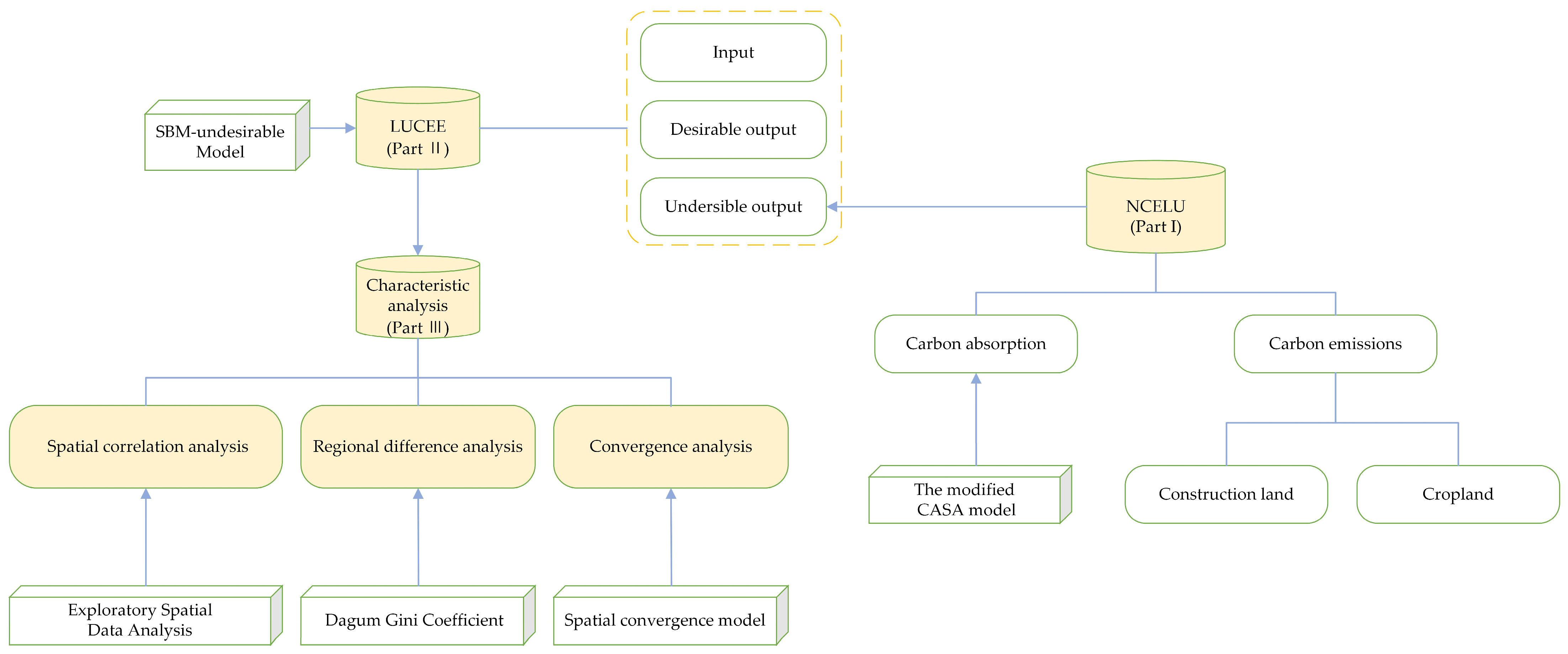
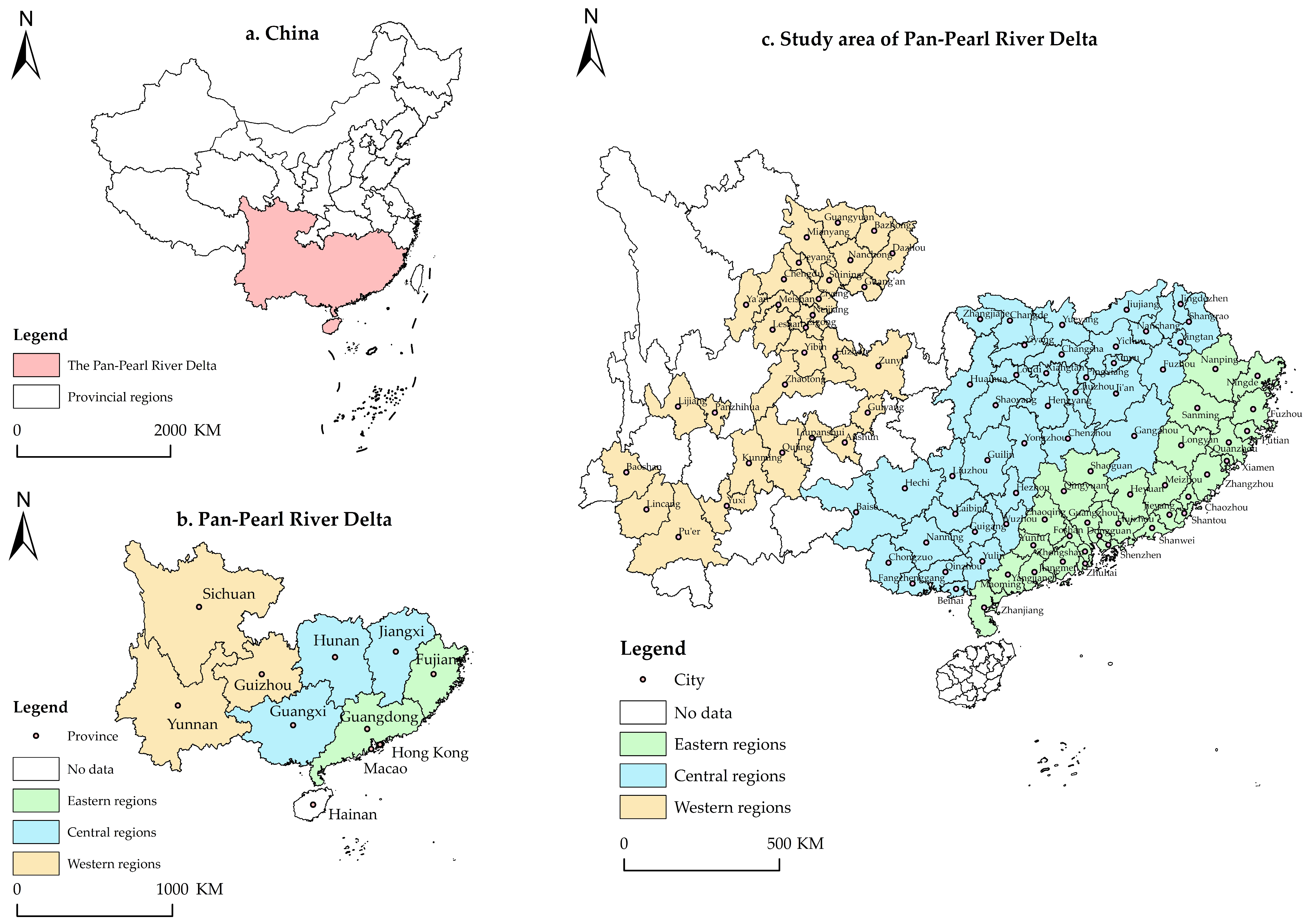
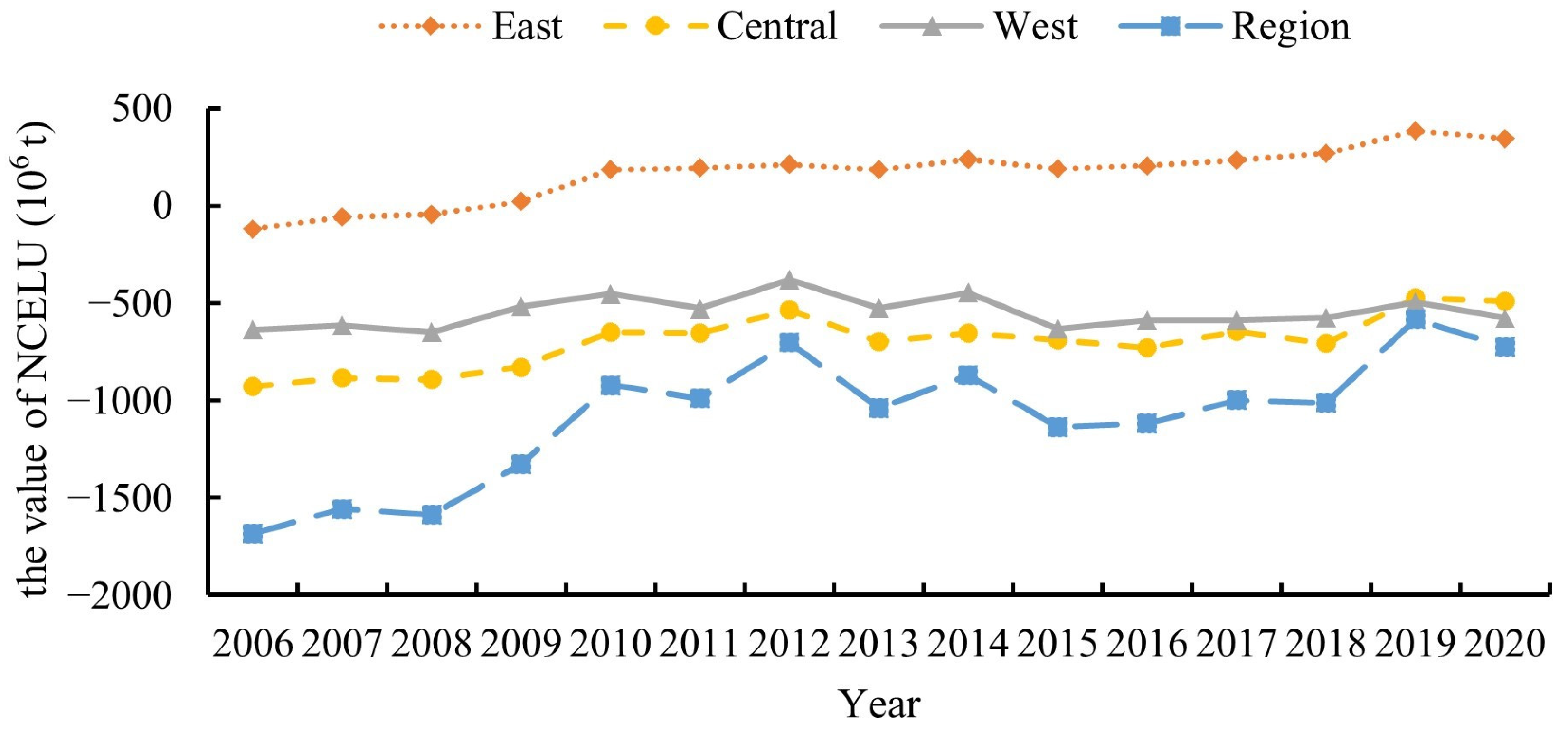

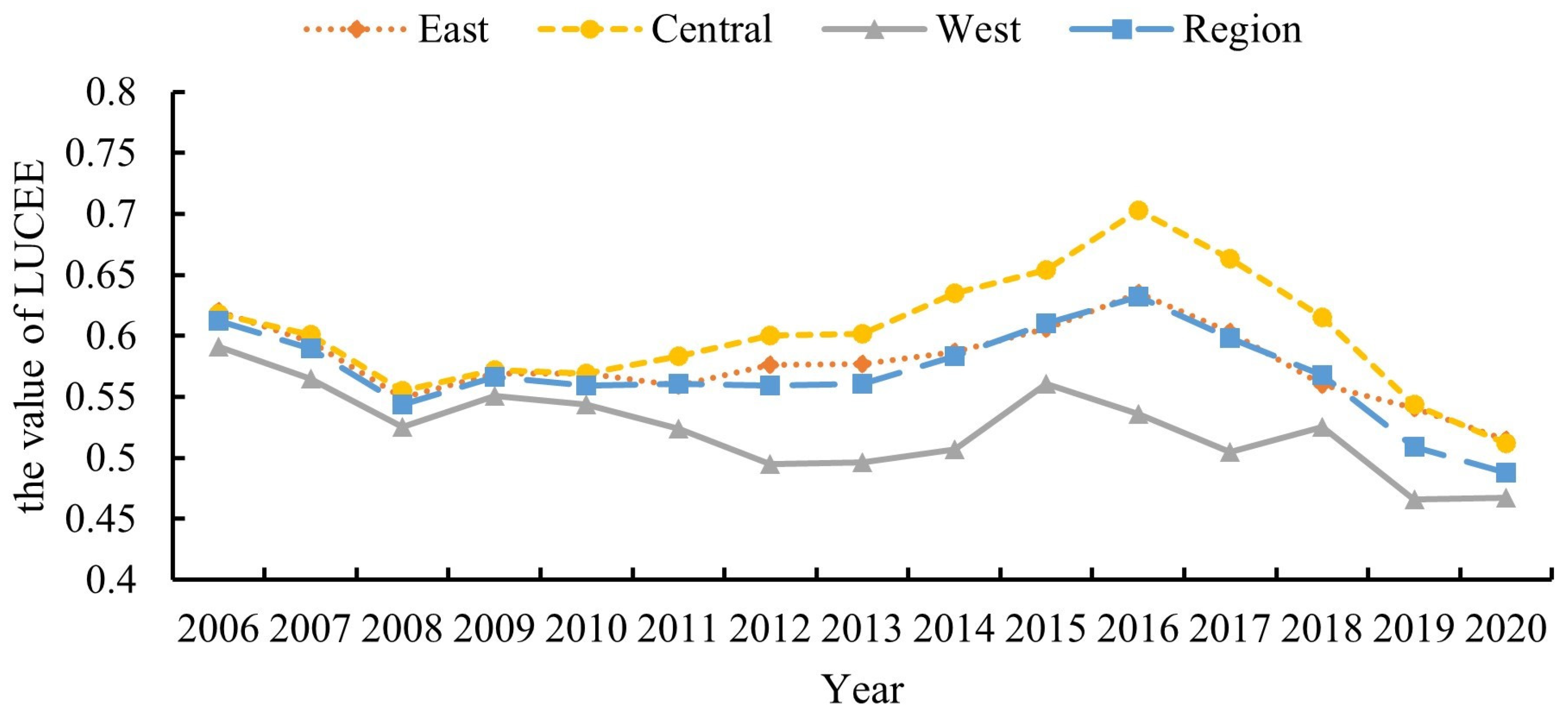

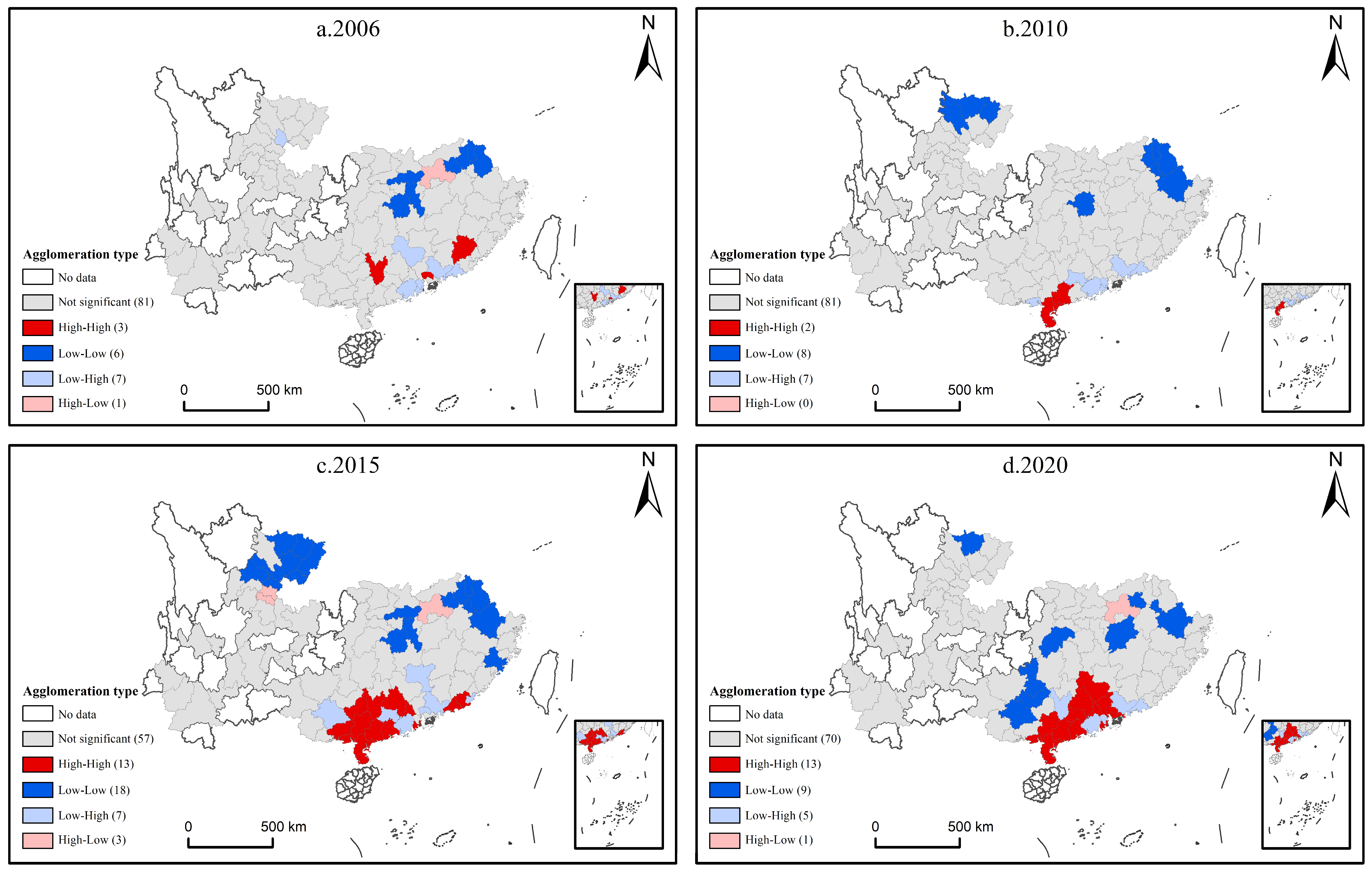
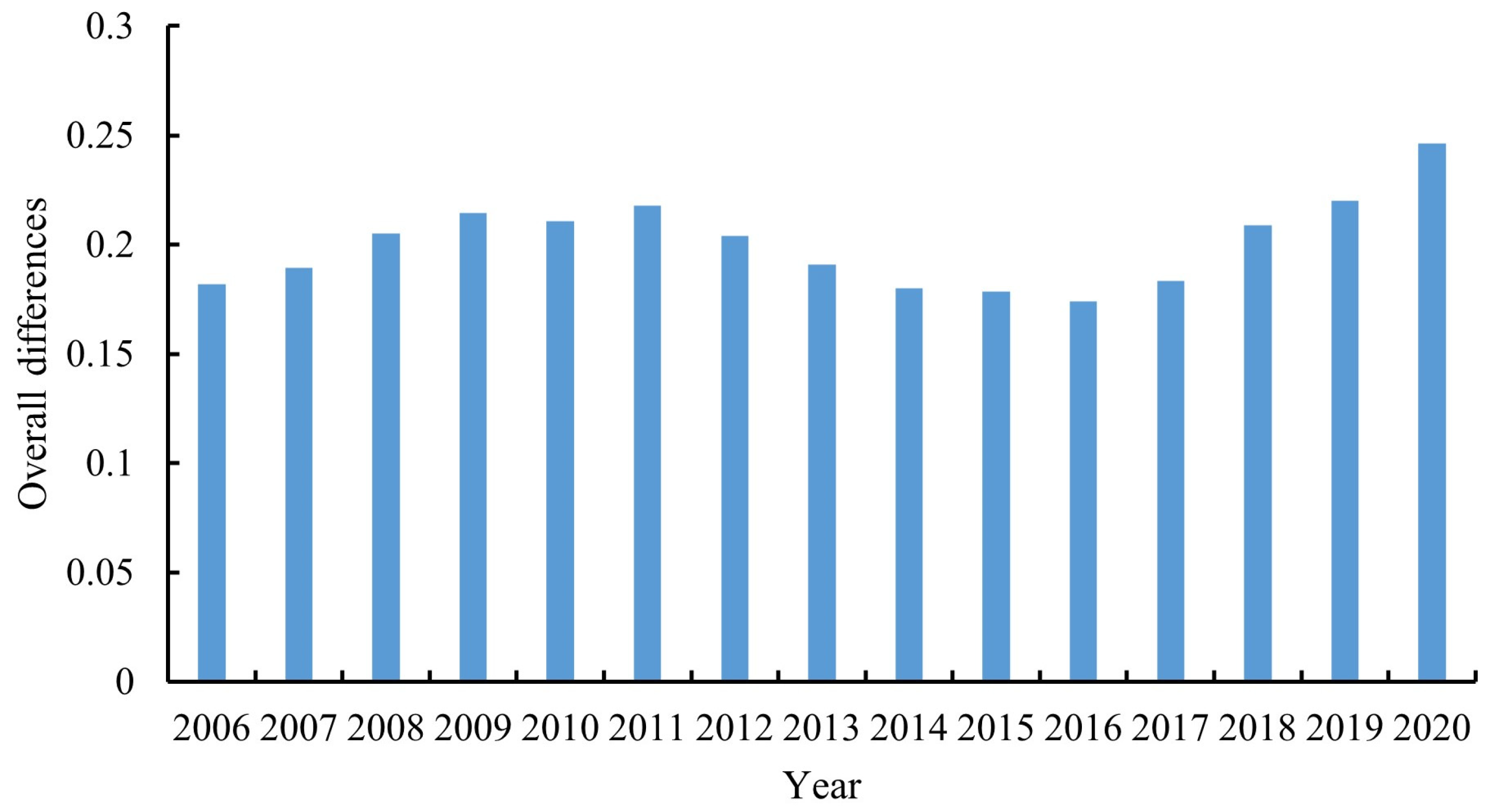


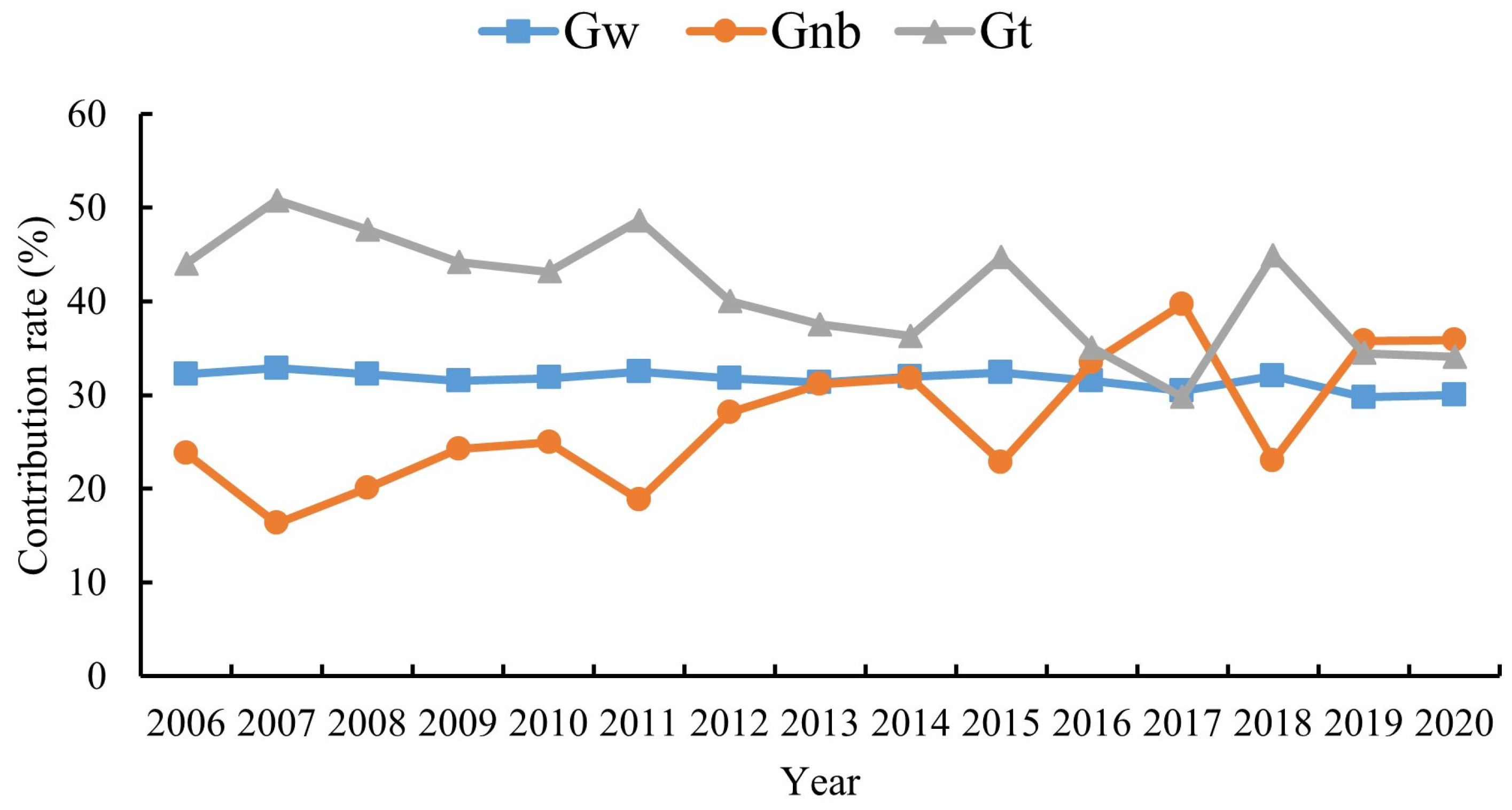
| Province | K | R2 |
|---|---|---|
| Fujian | 0.0396 | 0.9701 |
| Jiangxi | 0.0599 | 0.9500 |
| Hunan | 0.0702 | 0.8969 |
| Guangdong | 0.0403 | 0.9880 |
| Guangxi | 0.0500 | 0.9837 |
| Sichuan | 0.0551 | 0.8941 |
| Guizhou | 0.0800 | 0.8464 |
| Yunnan | 0.0539 | 0.9792 |
| Variable | Measurement | Selection Reasons |
|---|---|---|
| Economic development level (ECO) | Expressed as GDP per capita | Regions with more advanced economic development can allocate more production factors to improve the LUCEE. These regions typically experience severe ecological damage, which can also have adverse effects on the LUCEE. |
| Industrial structure (IND) | Expressed as the ratio of tertiary to secondary output | This variable profoundly influences the energy structure. Industries characterized by high energy consumption and significant polluting levels are notable contributors to carbon emissions. A well-optimized industrial structure can effectively reduce carbon emissions, thus enhancing the LUCEE. |
| Population density (POP) | Expressed as the ratio of the total population in each city at the end of the year to the area of the administrative district | Regions with a high population density typically generate agglomeration effects, resulting in improved efficiency in land and energy utilization, thereby enhancing the LUCEE. However, a significantly high population density can also elevate energy consumption and strain the ecological carrying capacity of the land, restraining the enhancement of the LUCEE. |
| Foreign investment level (FDI) | Expressed as the ratio of the actual utilized foreign investment amount, converted based on the annual exchange rate, to the GDP for each prefecture-level city | The introduction of high-quality foreign investment is beneficial for improving the technological level in the study area, reducing energy consumption, decreasing carbon emissions, and enhancing the LUCEE. However, the introduction of foreign investment with high pollution may have the opposite effect. |
| Technical innovation level (INN) | Expressed as the proportion of R&D expenditure to GDP | The advancement in technical level can improve the land use efficiency and energy utilization, promote green economic growth, and enhance the LUCEE to a certain extent. In comparison with other indicators, the R&D investment of a region more accurately reflects its technological innovation capability; thus, its direct influence on the LUCEE is more pronounced. |
| Land use intensity (LUI) | Calculated using the assignment method by assigning values to the different types of land use (refer to relevant references for details of the calculation [55]) | Land use intensity reflects the extent of exploitation and utilization of various land types. Studies have shown a significant positive correlation between land use intensity enhancement and urban carbon emissions [56].Therefore, land use intensity may affect the LUCEE through its influence on carbon emissions. |
| Index Type | Index Description | Index Meaning | Index Unit |
|---|---|---|---|
| Labor input per unit of land area | (Urban end-of-year employed population in urban units + urban private and individual employed population)/regional land area | Person/hm2 | |
| Input indicators | Fixed asset input per unit of land area | Gross fixed asset formation/regional land area | 104 yuan/hm2 |
| Technological input per unit of land area | R&D expenditure/regional land area | 104 yuan/hm2 | |
| Desirable output | Economic output per unit of land area | Gross GDP/regional land area | 104 yuan/hm2 |
| Undesirable output | Net carbon emission output per unit of land area | NCELU/regional land area | t/hm2 |
| Research Content | Data Sources | Data Processing |
|---|---|---|
| Estimation of carbon emissions from construction land | The NTL data are from the research finding of Wu et al. (https://doi.org/10.7910/DVN/GIYGJU, accessed on 23 September 2023) [57]. The energy consumption data are from the China Energy Statistics Yearbook. | ArcGIS software is utilized to perform zonal statistics on NTL data, obtaining the total NTL values for each province and city. |
| Estimation of carbon emissions from cropland | The agricultural data are from the provincial and municipal statistical yearbooks, rural statistical yearbooks, and statistical bulletin. | Individual missing data are completed by interpolation. |
| Estimation of land use carbon absorption | The relevant meteorological data are from the China Meteorological Data Service Center (https://data.cma.cn/, accessed on 12 October 2023). The NDVI data are from the China Tibetan Plateau Science Data Center (https://data.tpdc.ac.cn/zh-hans/data/10535b0b-8502-4465-bc53-78bcf24387b3, accessed on 15 October 2023) [58]. The land use data are from annual China land cover dataset (CLCD) (https://zenodo.org/record/8176941, accessed on 15 October 2023) [59]. | The relevant meteorological data are interpolated to obtain the required meteorological raster data. The land use data are resampled to ensure spatial resolution consistency with other data, all at a resolution of 250 m. Meanwhile, the land types are reclassified into cropland, woodland, grassland, water area, construction land, and unused land by referring to the land use classification system of the Chinese Academy of Sciences. |
| Measurement of LUCEE and conditional convergence analysis | The statistical data for the input and output variables required for efficiency measurement and the control variables required for conditional convergence analysis are from the China Urban Statistical Yearbook, the China Science and Technology Statistical Yearbook, the National Statistics Bulletin on Scientific and Technological Expenditure Inputs, and the statistical yearbooks and bulletins of the provinces and municipalities. The land area data are from the CLCD dataset. | All indicators involving prices are deflated with 2006 as the base period to eliminate the influence of the price factor. Individual missing data are completed by interpolation. |
| 2006 to 2020 | Cropland | Woodland | Grassland | Water Area | Unused Land | Construction Land | Loss Area |
|---|---|---|---|---|---|---|---|
| Cropland | 350,550.07 | 51,001.61 | 2430.73 | 2378.98 | 23.06 | 11,613.43 | 67,447.81 |
| Woodland | 52,145.84 | 808,547.30 | 655.60 | 82.70 | 1.74 | 1279.16 | 54,165.04 |
| Grassland | 4027.26 | 3214.99 | 9942.38 | 157.71 | 45.47 | 326.29 | 7771.72 |
| Water area | 3172.99 | 177.35 | 50.06 | 19,712.01 | 32.72 | 829.94 | 4263.06 |
| Unused land | 10.98 | 1.14 | 48.21 | 45.96 | 72.36 | 16.93 | 123.22 |
| Construction land | 69.96 | 1.04 | 0.61 | 532.7 | 0.40 | 21,385.63 | 604.71 |
| Gain land | 59,427.03 | 54,396.13 | 3185.21 | 3198.05 | 103.39 | 14,065.75 | 134,375.56 |
| Variation | −8020.78 | 231.09 | −4586.51 | −1065.01 | −19.83 | 13,461.04 |
| Year | G-Moran’s I | Z-Value | p-Value | Year | G-Moran’s I | Z-Value | p-Value |
|---|---|---|---|---|---|---|---|
| 2006 | 0.1363 | 2.0176 | 0.0266 | 2014 | 0.3807 | 5.3581 | 0.0000 |
| 2007 | 0.0944 | 1.4440 | 0.0788 | 2015 | 0.3517 | 4.9608 | 0.0000 |
| 2008 | 0.1275 | 1.9003 | 0.0353 | 2016 | 0.4332 | 6.0651 | 0.0000 |
| 2009 | 0.1285 | 1.9115 | 0.0332 | 2017 | 0.5088 | 7.1441 | 0.0000 |
| 2010 | 0.1704 | 2.4811 | 0.0102 | 2018 | 0.2829 | 4.0193 | 0.0001 |
| 2011 | 0.1968 | 2.8417 | 0.0043 | 2019 | 0.3054 | 4.3633 | 0.0002 |
| 2012 | 0.2756 | 3.9268 | 0.0003 | 2020 | 0.2715 | 3.8997 | 0.0004 |
| 2013 | 0.3713 | 5.2333 | 0.0000 |
| Year | Overall | Intra-Regional Differences | Inter-Regional Differences | Contribution Rate (%) | ||||||
|---|---|---|---|---|---|---|---|---|---|---|
| East | Central | West | East– Central | East– West | Central– West | |||||
| 2006 | 0.1819 | 0.1665 | 0.1819 | 0.1748 | 0.1923 | 0.1826 | 0.1806 | 32.20 | 23.82 | 43.99 |
| 2007 | 0.1893 | 0.1868 | 0.1866 | 0.1798 | 0.1968 | 0.1933 | 0.1844 | 32.85 | 16.34 | 50.81 |
| 2008 | 0.2050 | 0.2083 | 0.1795 | 0.2101 | 0.2112 | 0.2195 | 0.1978 | 32.22 | 20.11 | 47.68 |
| 2009 | 0.2143 | 0.2047 | 0.1767 | 0.2365 | 0.2178 | 0.2314 | 0.2139 | 31.55 | 24.27 | 44.18 |
| 2010 | 0.2108 | 0.2049 | 0.1844 | 0.2189 | 0.2197 | 0.2229 | 0.2060 | 31.83 | 24.99 | 43.19 |
| 2011 | 0.2178 | 0.2165 | 0.2058 | 0.2112 | 0.2248 | 0.2301 | 0.2104 | 32.50 | 18.87 | 48.63 |
| 2012 | 0.2039 | 0.1974 | 0.1849 | 0.1986 | 0.2064 | 0.2293 | 0.1969 | 31.76 | 28.17 | 40.07 |
| 2013 | 0.1909 | 0.1741 | 0.1685 | 0.1982 | 0.1897 | 0.2188 | 0.1882 | 31.33 | 31.14 | 37.53 |
| 2014 | 0.1799 | 0.1672 | 0.1856 | 0.1461 | 0.1874 | 0.1920 | 0.1759 | 31.94 | 31.77 | 36.29 |
| 2015 | 0.1785 | 0.1670 | 0.1706 | 0.1795 | 0.1789 | 0.1910 | 0.1776 | 32.43 | 22.86 | 44.71 |
| 2016 | 0.1739 | 0.1723 | 0.1758 | 0.1214 | 0.1802 | 0.1917 | 0.1703 | 31.51 | 33.45 | 35.04 |
| 2017 | 0.1833 | 0.1740 | 0.1903 | 0.1088 | 0.2038 | 0.2060 | 0.1661 | 30.48 | 39.70 | 29.82 |
| 2018 | 0.2089 | 0.2050 | 0.2083 | 0.1780 | 0.2256 | 0.2185 | 0.1962 | 32.08 | 22.99 | 44.93 |
| 2019 | 0.2199 | 0.1987 | 0.1919 | 0.1987 | 0.2530 | 0.2421 | 0.1973 | 29.75 | 35.76 | 34.49 |
| 2020 | 0.2461 | 0.2131 | 0.2133 | 0.2457 | 0.2757 | 0.2593 | 0.2367 | 30.01 | 35.88 | 34.11 |
| average value | 0.2003 | 0.1904 | 0.1869 | 0.1871 | 0.2109 | 0.2152 | 0.1932 | 31.63 | 27.34 | 41.03 |
| Test Parameters | Absolute β Convergence | Conditional β Convergence | ||
|---|---|---|---|---|
| T-Statistic | Prob. | T-Statistic | Prob. | |
| Hausman | 324.100 | 0.000 | 319.270 | 0.000 |
| LM-lag | 228.051 | 0.000 | 142.967 | 0.000 |
| RLM-lag | 1.560 | 0.212 | 1.848 | 0.174 |
| LM-error | 249.246 | 0.000 | 176.101 | 0.000 |
| RLM-error | 22.755 | 0.000 | 34.982 | 0.000 |
| Variable | Absolute β Spatial Convergence | Conditional β Spatial Convergence | ||||||
|---|---|---|---|---|---|---|---|---|
| Region | East | Central | West | Region | East | Central | West | |
| β | −0.4143 *** | −0.2573 *** | −0.5069 *** | −0.3960 *** | −0.4149 *** | −0.2669 *** | −0.5136 *** | −0.4350 *** |
| (0.0190) | (0.0294) | (0.0329) | (0.0338) | (0.0190) | (0.0290) | (0.0340) | (0.0351) | |
| ECO | 0.0124 * | −0.0078 | 0.0903 ** | 0.0956 | ||||
| (0.0075) | (0.0095) | (0.0492) | (0.0691) | |||||
| IND | 0.0772 *** | 0.1586 *** | 0.0535 | 0.0203 | ||||
| (0.0231) | (0.0322) | (0.0384) | (0.0510) | |||||
| POP | 0.0727 | −0.8132 ** | 0.9788 | 0.1965 * | ||||
| (0.0943) | (0.3376) | (4.6180) | (0.1163) | |||||
| FDI | −0.7916 * | 0.3726 | −4.4761 *** | 1.0011 | ||||
| (0.4418) | (0.5274) | (1.0215) | (0.8459) | |||||
| INN | −0.0212 * | 0.0074 | −0.0027 | −0.0232 | ||||
| (0.0111) | (0.0224) | (0.0195) | (0.0173) | |||||
| LUI | −0.5965 | 0.7363 | 0.6437 | −15.1327 *** | ||||
| (0.9287) | (0.8509) | (2.2464) | (3.7630) | |||||
| λ | 0.3331 *** | −0.1052 | −0.0449 | 0.0926 | 0.3308 *** | −0.2290 | −0.1767 | 0.1296 |
| (0.1213) | (0.1919) | (0.1659) | (0.1672) | (0.1228) | (0.2145) | (0.1846) | (0.1666) | |
| s | 0.0382 | 0.0212 | 0.0505 | 0.0360 | 0.0383 | 0.0222 | 0.0515 | 0.0408 |
| R2 | 0.2645 | 0.1706 | 0.3262 | 0.2445 | 0.2790 | 0.2282 | 0.3417 | 0.2813 |
Disclaimer/Publisher’s Note: The statements, opinions and data contained in all publications are solely those of the individual author(s) and contributor(s) and not of MDPI and/or the editor(s). MDPI and/or the editor(s) disclaim responsibility for any injury to people or property resulting from any ideas, methods, instructions or products referred to in the content. |
© 2024 by the authors. Licensee MDPI, Basel, Switzerland. This article is an open access article distributed under the terms and conditions of the Creative Commons Attribution (CC BY) license (https://creativecommons.org/licenses/by/4.0/).
Share and Cite
Fan, Z.; Xia, W.; Yu, H.; Liu, J.; Liu, B. Spatiotemporal Pattern and Spatial Convergence of Land Use Carbon Emission Efficiency in the Pan-Pearl River Delta: Based on the Difference in Land Use Carbon Budget. Land 2024, 13, 634. https://doi.org/10.3390/land13050634
Fan Z, Xia W, Yu H, Liu J, Liu B. Spatiotemporal Pattern and Spatial Convergence of Land Use Carbon Emission Efficiency in the Pan-Pearl River Delta: Based on the Difference in Land Use Carbon Budget. Land. 2024; 13(5):634. https://doi.org/10.3390/land13050634
Chicago/Turabian StyleFan, Zhenggen, Wentong Xia, Hu Yu, Ji Liu, and Binghua Liu. 2024. "Spatiotemporal Pattern and Spatial Convergence of Land Use Carbon Emission Efficiency in the Pan-Pearl River Delta: Based on the Difference in Land Use Carbon Budget" Land 13, no. 5: 634. https://doi.org/10.3390/land13050634





